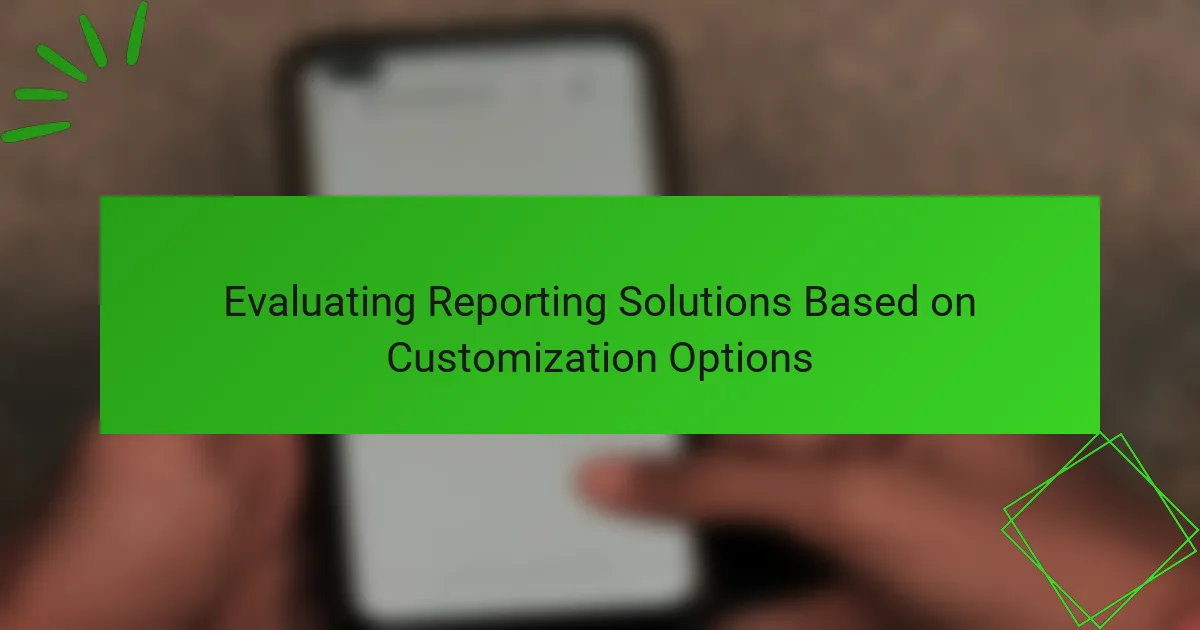When selecting a reporting solution, the ability to customize reports is crucial for meeting specific user needs and enhancing overall effectiveness. Solutions that feature intuitive interfaces, customizable templates, and strong integration capabilities empower users to create tailored reports that improve clarity and relevance. By carefully evaluating these customization options, organizations can ensure that their reporting tools align with unique workflows and decision-making processes.

What are the best reporting solutions for customization in the US?
The best reporting solutions for customization in the US include tools that allow users to tailor reports to their specific needs. These solutions offer various features such as drag-and-drop interfaces, customizable templates, and integration capabilities with other data sources.
Tableau
Tableau is renowned for its robust customization options, enabling users to create interactive and visually appealing reports. Its drag-and-drop functionality allows users to easily manipulate data and design dashboards that fit their unique requirements.
Consider using Tableau if you need to visualize complex data sets or require advanced analytics. Its extensive library of plugins and community resources can further enhance customization, making it suitable for both small businesses and large enterprises.
Power BI
Power BI offers a user-friendly interface with a variety of customization features, including custom visuals and report themes. Users can create tailored dashboards and reports that align with their business goals and branding.
This solution is particularly beneficial for organizations already using Microsoft products, as it integrates seamlessly with tools like Excel and Azure. Keep in mind that while Power BI is powerful, it may require some learning to fully leverage its customization capabilities.
Looker
Looker stands out for its data modeling layer, which allows users to define metrics and dimensions that can be reused across reports. This feature promotes consistency and customization, making it easier to generate tailored insights.
Looker is ideal for companies that prioritize data governance and want to ensure that all users are working with the same definitions. However, it may require a more technical setup compared to other tools, so consider your team’s capabilities before choosing Looker.
Google Data Studio
Google Data Studio is a free reporting tool that provides a high level of customization with its easy-to-use interface. Users can create interactive reports using various data sources, including Google Analytics and Google Sheets.
This solution is perfect for small businesses or startups looking for a cost-effective way to visualize data. However, while it offers flexibility, the depth of customization may not match that of more advanced tools like Tableau or Power BI.
Qlik Sense
Qlik Sense offers a unique associative data model that allows for deep customization of reports and dashboards. Users can explore data freely and create personalized visualizations that cater to specific analytical needs.
This tool is particularly useful for organizations that require real-time data analysis and interactive reporting. However, the learning curve can be steep, so ensure your team is prepared to invest time in mastering its features for optimal customization.

How do customization options impact reporting effectiveness?
Customization options significantly enhance reporting effectiveness by allowing users to tailor reports to their specific needs, thereby improving clarity and relevance. Effective customization can lead to better decision-making as stakeholders receive information that directly addresses their unique requirements.
Enhanced data visualization
Enhanced data visualization transforms complex data into clear, digestible formats. Customizable charts, graphs, and dashboards enable users to highlight key metrics and trends that matter most to their objectives. For instance, a sales report can feature dynamic graphs that adjust based on selected time frames or product categories.
Consider using color coding or interactive elements to make data more engaging. This not only aids in comprehension but also helps in quickly identifying areas needing attention, such as underperforming products or regions.
Improved user engagement
Improved user engagement is achieved when reporting solutions allow for personalization, making the data more relatable to the end-user. Features like customizable layouts and the ability to select preferred metrics encourage users to interact with the reports actively. This engagement can lead to higher retention of information and better-informed discussions.
To foster engagement, consider incorporating user feedback mechanisms within the reporting tools. This allows users to suggest features or changes, ensuring the reports evolve to meet their needs effectively.
Tailored insights
Tailored insights are crucial for organizations aiming to derive actionable intelligence from their data. Customization options enable users to filter and segment data based on specific criteria, such as demographics or performance indicators. This targeted approach allows for deeper analysis and more relevant conclusions.
For example, a marketing team can customize reports to focus on customer segments that yield the highest ROI, facilitating strategic planning. Regularly reviewing and adjusting these parameters ensures that insights remain aligned with changing business goals.

What factors should be considered when evaluating customization options?
When evaluating customization options for reporting solutions, consider user interface flexibility, integration capabilities, and the cost of customization. These factors will help determine how well a solution can adapt to your specific needs and workflows.
User interface flexibility
User interface flexibility refers to how easily a reporting solution can be tailored to meet the unique preferences of its users. Look for options that allow for customizable dashboards, report layouts, and data visualization tools. A flexible interface can significantly enhance user experience and engagement.
Consider whether the solution supports drag-and-drop features, theme customization, and the ability to save personalized views. These elements can greatly improve usability and efficiency, especially for teams with diverse reporting needs.
Integration capabilities
Integration capabilities are crucial for ensuring that your reporting solution can seamlessly connect with other systems and data sources. Evaluate whether the solution offers APIs, connectors, or built-in integrations with popular software like CRM, ERP, or data warehousing tools.
Strong integration capabilities can reduce data silos and streamline workflows, allowing for real-time data updates and more comprehensive reporting. Assess the ease of integration and the level of technical support available for implementation.
Cost of customization
The cost of customization can vary widely depending on the complexity of the changes and the vendor’s pricing model. It’s essential to understand both the initial setup costs and any ongoing expenses associated with maintaining custom features. Some solutions may offer tiered pricing based on the level of customization required.
Consider whether the customization is a one-time investment or if it will incur recurring fees for updates and support. Additionally, weigh the potential return on investment by evaluating how much time and resources the customization will save your team in the long run.

What are the top features of customizable reporting solutions?
Customizable reporting solutions offer flexibility in data presentation, allowing users to tailor reports to their specific needs. Key features include dynamic dashboards, custom report templates, and API access for seamless data integration.
Dynamic dashboards
Dynamic dashboards provide real-time data visualization, enabling users to monitor key performance indicators (KPIs) at a glance. These dashboards can be customized to display relevant metrics, charts, and graphs that reflect the user’s unique business requirements.
When evaluating dynamic dashboards, consider the ease of customization and the ability to filter data based on specific criteria. Look for solutions that allow drag-and-drop functionality for quick adjustments and real-time updates to ensure you are always viewing the most current information.
Custom report templates
Custom report templates allow users to create standardized reports that can be reused across different projects or departments. This feature saves time and ensures consistency in reporting by allowing users to define the structure and content of their reports.
When selecting a reporting solution, check if it offers a library of pre-built templates that can be easily modified. Additionally, ensure that the templates can accommodate various data sources and formats, which enhances the versatility of the reporting process.
API access for data integration
API access is crucial for integrating reporting solutions with other software systems, enabling seamless data flow between platforms. This feature allows users to pull data from multiple sources, ensuring that reports are comprehensive and up-to-date.
When assessing API capabilities, consider the ease of use and the level of documentation provided. A well-documented API can significantly reduce the time required for integration and troubleshooting, making it easier for teams to leverage data from various applications effectively.

How do pricing models vary among reporting solutions?
Pricing models for reporting solutions can differ significantly, primarily falling into two categories: subscription-based pricing and one-time license fees. Understanding these models helps organizations choose the most cost-effective option based on their needs and usage patterns.
Subscription-based pricing
Subscription-based pricing typically involves a recurring fee, often monthly or annually, granting users access to the reporting solution. This model is advantageous for businesses seeking flexibility, as it allows for scaling up or down based on changing requirements.
Costs can vary widely, generally ranging from low tens of USD to several hundred USD per month, depending on features and user count. Organizations should consider the total cost of ownership, including potential upgrades and support services, when evaluating this model.
One-time license fees
One-time license fees require a single upfront payment for perpetual use of the reporting software. This model can be appealing for companies that prefer to avoid ongoing costs and have predictable reporting needs.
While the initial investment can be substantial, often in the range of hundreds to thousands of USD, it eliminates recurring fees. However, organizations should be aware of potential additional costs for updates, maintenance, and support, which may arise over time.










